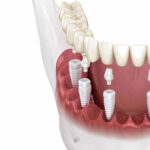Gum disease is caused by harmful bacteria that gradually destroys bone and other structures supporting people’s teeth. If it is not immediately taken care of, gum disease can lead to tissue loss, bone loss, tooth loss, and numerous other systemic health problems. Luckily, when people go to a skilled and trusted periodontists office, they can receive proven gum disease treatments in Bloomfield Hills, MI.
Want to learn more about the specific types of gum disease treatments people can receive? Continue reading to learn more about what they are, and how they can help improve people’s oral health.
The Types Of Gum Disease Treatments In Bloomfield Hills, MI You Can Receive
Gum disease is an infection that starts in the soft tissues of the mouth. The sooner a quality periodontist can remove the damaging oral bacteria, the sooner their mouth can begin to heal from it. However, gum disease treatment extends beyond just eliminating bad oral bacteria. Gum disease treatment also includes removing damaged tissues and correcting any problems that have been caused by unmanaged gum disease.
In the early stage of gum disease, known as gingivitis, its damage to the surrounding tissues and structures of the mouth tends to be minimal. In the more severe stages of gum disease, the damage is usually more widespread. At an advanced periodontist’s office, ozone therapy, laser gum disease treatments (BIOLASE® WaterLase Epress and Epic X™), and PRF are leading procedures used to treat gum disease.
The following describes how each advanced gum disease procedure can restore a patients smile:
Ozone Therapy:
Ozone therapy is a safe, holistic way to treat oral infections, disinfect the affected areas of
the mouth and promote healing. It is fast becoming a requested type of treatment method
among periodontal patients.
Laser Gum Disease Treatments:
The BIOLASE® WaterLase Express and EPIC X™ laser gum disease treatments are reliable, predictable, and safe ways for the periodontist to eradicate destructive oral bacteria while also gently vaporizing dead and diseased tissue. With laser gum disease treatments, the gum disease patient’s gum health is restored.
PRF:
PRF (Platelet Rich Fibrin) contains growth factors that help patients heal after their surgical procedure(s) for both traditional and advanced gum disease.
For those who want their gum disease treated with a more conservative approach, these are the types of gum disease procedures they can have.
Scaling And Root Planing:
Scaling and root planing is a minimally invasive gum disease treatment that involves the periodontist gently gaining access to the areas deep within the periodontal pockets formed between the gums and teeth, where the harmful bacteria has accumulated. When people receive scaling and root planing, bacteria is gently and thoroughly addressed by disrupting the biofilm layer through the removal of tartar and plaque buildup.
Osseous Surgery:
For those with more advanced gum disease, osseous surgery may be the best procedure option. During osseous surgery, the periodontist first numbs the patient with sedation dentistry, then gently draws back gum tissue to gain access to the deep areas of infection.
The periodontist then debrides the tooth root surfaces of plaque and tartar and smooths the bone discrepancies created by gum disease. Resorbable sutures are then placed and the procedure site can heal.
Periodontal Maintenance:
Continued periodontal maintenance is necessary to maintain long-term gum and bone health following gum disease treatment. Periodontal maintenance cleanings and exams are necessary every three to four months to reduce the potential of people having a gum disease relapse and maintaining their periodontal health.
For those whose gum disease is still present, general cleanings (prophylaxis) every six months is not enough to prevent people from having a gum disease relapse.
Learn More About Gum Disease Treatments With Dr. Lauren Anderson
Interested in learning more about how high-quality gum disease treatments can restore the health of your smile? Our knowledgeable periodontal office has expert knowledge on which type of gum disease treatment you will need to restore the health of your smile.
Don’t hesitate to improve your smile with us. Get in contact with Dr. Lauren Anderson and our exceptional team at our Anderson Periodontal Wellness office to schedule an appointment today!





